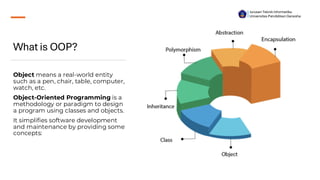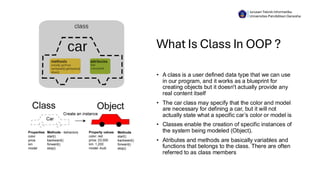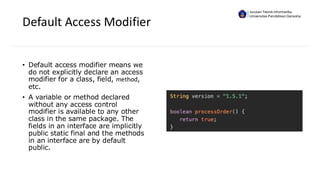Classes and Object Concept Object Oriented Programming in Java
- 1. Object and Classes Object Oriented Programming By. Ketut Agus Seputra
- 2. What is OOP? Object means a real-world entity such as a pen, chair, table, computer, watch, etc. Object-Oriented Programming is a methodology or paradigm to design a program using classes and objects. It simplifies software development and maintenance by providing some concepts: Jurusan Teknik Informatika Universitas Pendidikan Ganesha
- 3. What Is Class In OOP ? • A class is a user defined data type that we can use in our program, and it works as a blueprint for creating objects but it doesn't actually provide any real content itself • The car class may specify that the color and model are necessary for defining a car, but it will not actually state what a specific car’s color or model is • Classes enable the creation of specific instances of the system being modeled (Object). • Atributes and methods are basically variables and functions that belongs to the class. There are often referred to as class members Jurusan Teknik Informatika Universitas Pendidikan Ganesha
- 4. Example For example, if you want to create a class for students. In that case, "Student" will be a class, and student records (like student1, student2, etc) will be objects. Jurusan Teknik Informatika Universitas Pendidikan Ganesha
- 5. Properties of Java Classes • A class does not take any byte of memory. • A class is just like a real-world entity, but it is not a real-world entity. It's a blueprint where we specify the functionalities. • A class contains mainly two things: Methods and Data Members. • A class can also be a nested class. • Classes follow all of the rules of OOPs such as inheritance, encapsulation, abstraction, etc. Jurusan Teknik Informatika Universitas Pendidikan Ganesha
- 6. Creating (Declaring) a Java Class • Run in terminal touch Person.java Jurusan Teknik Informatika Universitas Pendidikan Ganesha
- 7. Types of Class Variables • Local variables − Variables defined inside methods, constructors or blocks are called local variables. The variable will be declared and initialized within the method and the variable will be destroyed when the method has completed. • Instance variables − Instance variables are variables within a class but outside any method. These variables are initialized when the class is instantiated. Instance variables can be accessed from inside any method, constructor or blocks of that particular class. • Class variables − Class variables are variables declared within a class, outside any method, with the static keyword. Jurusan Teknik Informatika Universitas Pendidikan Ganesha
- 8. Important Points About Variables Scope By default, a variable has default access. Default access modifier means we do not explicitly declare an access modifier for a class, field, method, etc. A variable or method declared without any access control modifier is available to any other class in the same package. The fields in an interface are implicitly public static final and the methods in an interface are by default public. Java provides a number of access modifiers to set access levels for classes, variables, methods, and constructors. The four access levels are − default − Visible to the package. No modifiers are needed. private − Visible to the class only. public − Visible to the world. protected − Visible to the package and all subclasses.
- 9. Classes: Instance Fields • Instance variables are specific to each instance of the class which means that each object created from the class will have its own copy of these variables. These fields can be set in the following three ways: • If they are public, they can be set like this instanceName.fieldName = someValue; • They can be set by class methods. • They can be set by the constructor method (shown in the next exercise).
- 10. Method • Methods are repeatable, modular blocks of code used to accomplish specific tasks. We have the ability to define our own methods that will take input, do something with it, and return the kind of output we want. • Now, we’re going to learn how to create object behavior using methods. Jurusan Teknik Informatika Universitas Pendidikan Ganesha
- 11. Constructors • Rules for Creating Java Constructors • You must follow the below-given rules while creating Java constructors: • The name of the constructors must be the same as the class name. • Java constructors do not have a return type. Even do not use void as a return type. • There can be multiple constructors in the same class, this concept is known as constructor overloading. • The access modifiers can be used with the constructors, use if you want to change the visibility/accessibility of constructors. • Java provides a default constructor that is invoked during the time of object creation. If you create any type of constructor, the default constructor (provided by Java) is not invoked.
- 12. Constructor Method in Java • Java classes contain a constructor method which is used to create instances of the class. • The constructor is named after the class. If no constructor is defined, a default empty constructor is used.
- 13. Types of Java Constructors
- 14. What are Java Objects? An object is a variable of the type class, it is a basic component of an object- oriented programming system. A class has the methods and data members (attributes), these methods and data members are accessed through an object. Thus, an object is an instance of a class. Jurusan Teknik Informatika Universitas Pendidikan Ganesha
- 15. Creating (Declaring) a Java Object • Declaration − A variable declaration with a variable name with an object type. • Instantiation − The 'new' keyword is used to create the object. • Initialization − The 'new' keyword is followed by a call to a constructor. This call initializes the new object. Jurusan Teknik Informatika Universitas Pendidikan Ganesha
- 16. Accessing Instance Variables and Methods • Instance variables and methods are accessed via created objects. To access an instance variable, following is the fully qualified path − Jurusan Teknik Informatika Universitas Pendidikan Ganesha
- 17. Java instance Example • Java instances are objects that are based on classes. For example, Bob may be an instance of the class Person. • Every instance has access to its own set of variables which are known as instance fields, which are variables declared within the scope of the instance. Values for instance fields are assigned within the constructor method.
- 18. Rules for using the Classes and Objects Concepts • There can be only one public class per source file. • A source file can have multiple non-public classes. • The public class name should be the name of the source file as well which should be appended by .java at the end. For example − the class name is public class Employee{} then the source file should be as Employee.java. • If the class is defined inside a package, then the package statement should be the first statement in the source file. • If import statements are present, then they must be written between the package statement and the class declaration. If there are no package statements, then the import statement should be the first line in the source file. • Import and package statements will imply to all the classes present in the source file. It is not possible to declare different import and/or package statements to different classes in the source file. • Classes have several access levels and there are different types of classes; abstract classes, final classes, etc. We will be explaining about all these in the access modifiers chapter. Jurusan Teknik Informatika Universitas Pendidikan Ganesha
- 19. Access Modifiers • Java access modifiers are used to specify the scope of the variables, data members, methods, classes, or constructors. These help to restrict and secure the access (or, level of access) of the data. Default (No keyword required) Private Protected Public Jurusan Teknik Informatika Universitas Pendidikan Ganesha
- 20. Default Access Modifier • Default access modifier means we do not explicitly declare an access modifier for a class, field, method, etc. • A variable or method declared without any access control modifier is available to any other class in the same package. The fields in an interface are implicitly public static final and the methods in an interface are by default public. Jurusan Teknik Informatika Universitas Pendidikan Ganesha
- 21. Private Access Modifier • Methods, variables, and constructors that are declared private can only be accessed within the declared class itself. • Using the private modifier is the main way that an object encapsulates itself and hides data from the outside world. • Using the private modifier is the main way that an object encapsulates itself and hides data from the outside world. Jurusan Teknik Informatika Universitas Pendidikan Ganesha
- 22. Protected Access Modifier • Variables, methods, and constructors, which are declared protected in a superclass can be accessed only by the subclasses in other package or any class within the package of the protected members' class. • The protected access modifier cannot be applied to class and interfaces. Methods, fields can be declared protected, however methods and fields in a interface cannot be declared protected. • Protected access gives the subclass a chance to use the helper method or variable, while preventing a nonrelated class from trying to use it.
- 23. Public Access Modifier • A class, method, constructor, interface, etc. declared public can be accessed from any other class. Therefore, fields, methods, blocks declared inside a public class can be accessed from any class belonging to the Java Universe. • However, if the public class we are trying to access is in a different package, then the public class still needs to be imported. Because of class inheritance, all public methods and variables of a class are inherited by its subclasses. Jurusan Teknik Informatika Universitas Pendidikan Ganesha
- 24. Access Modifiers and Inheritance • Methods declared public in a superclass also must be public in all subclasses. • Methods declared protected in a superclass must either be protected or public in subclasses; they cannot be private. • Methods declared private are not inherited at all, so there is no rule for them. Jurusan Teknik Informatika Universitas Pendidikan Ganesha

















































![Lec 4 06_aug [compatibility mode]](https://cdn.slidesharecdn.com/ss_thumbnails/lec406augcompatibilitymode-130917012610-phpapp01-thumbnail.jpg?width=560&fit=bounds)






















